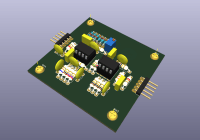High precision preemphasis

FM broadcasting in the Europe requires a 50us pre-emphasis for proper frequency response at the receiver. This is a high-precision pre-emphasis module that goes in front of the main broadcast limiter, but after the optional sibilance limiter.
Note new circuit mods to input. The two pole active low pass Butterworth filter alleviates a problem inherent in ALL preemphasis circuits: they keep on amplifying at a logrithmically-increasing rate, well above 15Khz, the upper useful limit of the FM audio. CDs contain substantial magnitudes of >15Khz energy spectra, and when this out of band energy is further amplified and presented to the limiter with a typical preemphasis system not having this LPF, the limiter will react on these out of band signals, thus causing unnecessary and loudness-robbing limiting effects when strong treble energy is present. This filter alleviates that problem.
The second modification is the bridge diode clamp on the preemphasis stage. This clamp leaves the frequency response alone, up until a certain threshold in program levels and treble content. When levels become excessive, the diode bridge forms a soft clipper, which acts more like a rapid-recovery compressor than a clipper. It's AC-coupled.
These two modifications have all but removed the need for the Sibilance Limiter. In fact, over 90% of the program I tested showed no gain pumping on vocal sibilance and cymbal crashes and average modulation levels remained high. I ran some exhaustive comparisons against the three other local FM stations, while making sure that my modulation levels were set to infrequent peaks of 100%. The results were quite rewarding. In a casual flip across the dial, the audio from this station sounded brighter, crisper and cleaner than the competing FMs. In fact, in some cases, tuning to the other FMs was almost like switching from FM to AM --the other stations seemed to be lacking the real high end that makes for that tinkling bell-like clarity that we enjoy on CDs. In fact, a direct A-B with the CD source versus the air signal showed no significant loss of quality, even though I was using fairly agressive modulation limiting/program drive levels.
PS : For a 75µS curve change C14 ti C16 by 330pF
The second modification is the bridge diode clamp on the preemphasis stage. This clamp leaves the frequency response alone, up until a certain threshold in program levels and treble content. When levels become excessive, the diode bridge forms a soft clipper, which acts more like a rapid-recovery compressor than a clipper. It's AC-coupled.
These two modifications have all but removed the need for the Sibilance Limiter. In fact, over 90% of the program I tested showed no gain pumping on vocal sibilance and cymbal crashes and average modulation levels remained high. I ran some exhaustive comparisons against the three other local FM stations, while making sure that my modulation levels were set to infrequent peaks of 100%. The results were quite rewarding. In a casual flip across the dial, the audio from this station sounded brighter, crisper and cleaner than the competing FMs. In fact, in some cases, tuning to the other FMs was almost like switching from FM to AM --the other stations seemed to be lacking the real high end that makes for that tinkling bell-like clarity that we enjoy on CDs. In fact, a direct A-B with the CD source versus the air signal showed no significant loss of quality, even though I was using fairly agressive modulation limiting/program drive levels.
PS : For a 75µS curve change C14 ti C16 by 330pF




Discussie (2 opmerking(en))
RDTP 2 jaar geleden
rigmo 2 jaar geleden
charbel aoun 2 jaar geleden
Chris-H 3 jaar geleden
You will notice that the input and output filters are configured for 16 kHz (not the usual FM 15 kHz) - Mark tried to slightly extend the frequency response of his audio channels.
Club AC-News 3 jaar geleden
The schema was publied on the "K19 Radio"group on Facebook.
I drew a PCB for it because I am building an FM driver that can also be controlled by USB.
I can't find the website listed for the other modules.
RDTP 2 jaar geleden
Chris-H 2 jaar geleden
Later, Mark moved to a three-band limiter approach, with slightly differing time constants for the bass, mid range and treble. This overcame the problems of "pumping" which is common in single-band limiters because the big bass energy will cause the mid and top to "dip" on peaks.
The audio quality that Mark achieved with limited resources was remarkable, and for years his "AMN" website was a go-to for some broadcast engineers. He has since retired, and moved to South-East Asia, and the AMN website is no more - though you'll find it on the "Wayback Machine":
https://web.archive.org/web/20010610220828/http://amn92.tripod.com/Radio.htm
There you'll find a comprehensive archive of audio processing, stereo processing, PLL FM transmitter and other circuits.
siblimtr.gif (17kb)
limiter1.gif (45kb)